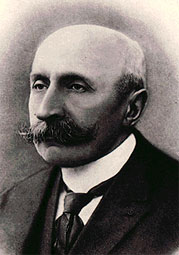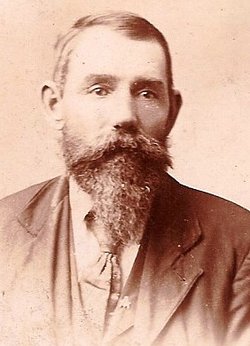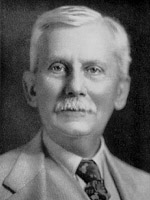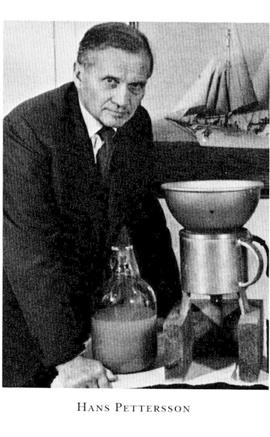Pierre Termier
Fussell, H. Alexander
H. Alexander Fussell (1859-1935) was an English-born Point Loma theosophist and a language teacher. In 1913 he wrote Modern Science and Atlantis(a), which was a supportive critique of Pierre Termier’s famous lecture, placing Atlantis in the Atlantic.
Schuller, Rudolph (Rudolfo)
Rudolph (Rudolfo) Schuller (1873-1932) was a linguist with a special interest in the languages of Central and South America. He served on the faculty of the National University in Mexico City.
Schuller along with Charles Schucert was invited by the American Geographical Society to present a review of Pierre Termier’s paper on Atlantis. Schuller gave cautious support for a possible American Atlantis, but also noted “The fact that the narrative of the island’s submersion has been regarded by most scholars as a “fabled tale” proves little or nothing.”
However, Schucert was more sceptical(a). Their comments were published in Geographical Review (Vol. 3, No. 1 (Jan., 1917), pp. 61-66) and more recently on Jason Colavito’s website(b).
*(a) https://www.jstor.org/stable/207366?seq=1#page_scan_tab_contents
(b) https://www.jasoncolavito.com/rebuttal-to-termier.html*
Mushketov, D.I. (L)
 Dmitrii Ivanovich Mushketov (1882-1938) was a Russian geologist who was greatly impressed by the work of Pierre Termier and voiced the view in the 1930’s that the Atlantis had been situated where we now have the Atlantic, which he believed was created in recent times by “subsidence and caving”.
Dmitrii Ivanovich Mushketov (1882-1938) was a Russian geologist who was greatly impressed by the work of Pierre Termier and voiced the view in the 1930’s that the Atlantis had been situated where we now have the Atlantic, which he believed was created in recent times by “subsidence and caving”.
He was described by Zhirov[0458.317] as the first Soviet geologist to express such firm belief in the existence of Atlantis.
Mushketov, along with some of his colleagues, was executed as part of Stalin’s purges.
Termier, Pierre
Pierre Termier (1859-1930) was a French geologist who analysed basaltic lava dredged up from the Atlantic seafloor 500 miles north of the Azores in 1898. Termier was confused  when he found that the sample was vitreous rather than crystalline. This had to mean that the water had been submerged after cooling. Since lava disintegrates after 15,000 years Termier was forced to conclude that there had been volcanic activity above sea level in the relatively recent past, perhaps coinciding with the destruction of Atlantis.
when he found that the sample was vitreous rather than crystalline. This had to mean that the water had been submerged after cooling. Since lava disintegrates after 15,000 years Termier was forced to conclude that there had been volcanic activity above sea level in the relatively recent past, perhaps coinciding with the destruction of Atlantis.
In 1912 Termier delivered a lecture[574] to the Institut Océanographique(b) in which he outlined his belief that Atlantis had been located in the Atlantic, a machine translation in English is available here as Archive 3667. A brief 9-page article by Termier, entitled New Light on the Lost Atlantis, has been reprinted by Kessinger Publishing. Termier also addressed the Smithsonian Institute who published his text in their 1915 annual.
In January 1917 a firm rebuttal of Termier’s ideas was written by Charles Schuchert of Yale University and published in Geographical Review,*however, the journal also published a favourable review by Rudolph Schuller in the same edition(a).*
In 1924 Termier he published La Derive des Continents, a paper in which he rejected Wegener’s theory of ‘Continental Drift’ as fanciful.
Although Termier’s claims are still quoted by some as factual, their scientific basis has been gravely undermined long ago, further weakening the case for Atlantis in the Atlantic.
*(a) https://www.jstor.org/stable/207366?seq=6#metadata_info_tab_contents*
(b) https://fr.wikisource.org/wiki/L%E2%80%99Atlantide_(Pierre_Termier) (French)
Babcock, William Henry
 William Henry Babcock (1849-1922) was born in St. Louis, Missouri and studied law, after which he took up newspaper work. He later moved to Washington, D.C. where he practised law.
William Henry Babcock (1849-1922) was born in St. Louis, Missouri and studied law, after which he took up newspaper work. He later moved to Washington, D.C. where he practised law.
Babcock was also a novelist and poet as well as the author of a number of works [069]+[070]+ on the Atlantic and pre-Columbian links between northern Europe and North America. His book Legendary islands of the Atlantic [071]+ is of particular interest. He refers to Atlantis but expresses the opinion that Plato’s story is a romantic combination of ancient legend together with an account of the defeat of the Persian army by the Athenians. In 1913, Babcock published Early Norse Visits to North America [069] in which he offers evidence of early Scandinavian visitors and returned to the subject in a 1921 paper entitled Recent History and Present Status of the Vinland Problem(b). In 1940, Hjalmar R. Holand published Norse Discoveries & Explorations in America 982-1362 [1824] that covered similar material, including a strong defence of the authenticity of the Kensington Stone(c)(d). It seems that Holand had some contact with another, apparently unrelated, Willoughby Babcock, curator of the Minnesota Historical Society Museum, during the preparation of the book [p.114,116].
In the May 1917 issue of The Geographical Review, Babcock wrote an article entitled ‘Atlantis and Antillia’ commenting on the views of Pierre Termier(a).
Referring to the sinking of Atlantis, Babcock wrote: “Moreover, the sudden submergence of so vast a region as the imagined Atlantis would be an event without parallel in human annals, besides being pretty certain to leave marks on the rest of the world which would be recognised even now.” He also remarks that regarding Plato’s story: “certainly no one will go the length of accepting it as wholly true as it stands.” Babcock’s views were quite understandable in view of Plato’s incredible dimensions for the island of Atlantis, namely 3,000 x 2,000 stades for the plain alone apart from its surrounding mountains.
[069]+ https://archive.org/details/earlynorsevisit01babcgoog
[070]+ https://archive.org/stream/jstor-207330/207330?ui=embed#page/n8/mode/1up
[071]+ https://archive.org/stream/jstor-207330/207330_djvu.txt
(a) https://atlantis.fyi/sources/atlantis-and-antillia
(b) https://catalog.hathitrust.org/Record/009610259
(c) https://en.wikipedia.org/wiki/Kensington_Runestone *
(d) https://www.mprnews.org/story/2009/10/17/rune-stone-champion-claims-more-evidence *
Pettersson, Professor Hans
Professor Hans Pettersson (1888-1966), was a renowned Swedish scientist, who became the first full professor of oceanography in Sweden and in 1938 founded the Institute of Oceanography in Gothenburg.
Thorwald C. Franke has written a short paper(b) on Pettersson’s important contribution to the Atlantis debates, offering scientific reasons for dismissing the idea of Atlantis being located in the Atlantic. In the process he refuted the earlier theories of Pierre Termier and demolished the idea of transatlantic land bridges.
Although he has excluded the Atlantic, he is equally unhappy with a Mediterranean location, preferring not to accept the Atlantis story as history!
He published his views, in Swedish, in 1944 as Atlantis och Atlanten, which was subsequently translated into German by another physicist, Stefan Meyer, entitled Atlantis und Atlantik[0503].
>An article on the Atlantisforschung website by Ferdinand Speidel offers a totally different view of Petterson’s Atlantis ‘scepticism’(c).<
Pettersson led the Swedish Albatross Expedition of 1947-1948 which surveyed the Atlantic. He subsequently spoke of finding evidence of “great catastrophes that have altered the face of the Earth”(a)
(a) Exploring the Ocean Floor (Scientific American, August 1950)
(b) https://www.atlantis-scout.de/atlantis-pettersson-english.htm
Schuchert, Charles
Charles Schuchert (1858-1942) was an outstanding American paleographer and palaeontologist and recipient of many  professional honours at home and abroad(a). In a paper entitled Atlantis and the Permanency of the North Atlantic Ocean Bottom delivered to the National Academy of Sciences in 1917(b), Schuchert concluded ‘that there was no known geologic data that prove or even help to prove the existence of Plato’s Atlantis in historic times’. He also noted ‘that the Azores are volcanic islands and are not composed of rocks seen on the continent’ and accepted the conclusions of the German geologist Curt Gagel(d) that five of the Cape Verde Islands and three of the Canaries are ‘unmistakably’ continental.
professional honours at home and abroad(a). In a paper entitled Atlantis and the Permanency of the North Atlantic Ocean Bottom delivered to the National Academy of Sciences in 1917(b), Schuchert concluded ‘that there was no known geologic data that prove or even help to prove the existence of Plato’s Atlantis in historic times’. He also noted ‘that the Azores are volcanic islands and are not composed of rocks seen on the continent’ and accepted the conclusions of the German geologist Curt Gagel(d) that five of the Cape Verde Islands and three of the Canaries are ‘unmistakably’ continental.
He also expressed similar views in a critique of Pierre Termier’s theory of Atlantis in the Atlantic in a paper published in the American Geographical Society’s Geographical Review of January 1917. The same review contained a similar response from Dr. Rudolph Schuller, a specialist in historical geography.
>(a) https://siarchives.si.edu/collections/siris_arc_217390<
(b) https://www.pnas.org/content/3/2/65.full.pdf+html
(c) https://www.jstor.org/stable/207366
(d)https://atlantisforschung.de/index.php?title=Curt_Gagel (German)
Germain, Louis (m)
Louis Germain (1878-1942) was a French zoologist who was among a number of commentators during the early part of the 20th century that identified Atlantis as a continent in the Atlantic,*[connected to the Iberian peninsula and what was later known as Mauritania in North-West Africa together with the Azores, Canaries and the Cape Verde archipelagos[0886]. He based his views on a study of molluscs on those islands as well as his suggested ancient links with the European and African mainlands.*]Improved geological and bathymetric studies gradually led to the abandonment of these ideas. Pierre Termier, a geologist, quoted Germain’s work to reinforce his own view that Atlantis had been located in the Atlantic.

